Your front door does more than just let people in—it makes a statement about your home right from the start. The color you pick says something about your personality and sets the mood for anyone who visits.
Remember to repin your favorite images!
Your front door color can totally change your home’s curb appeal and show off your style in ways you might not expect.
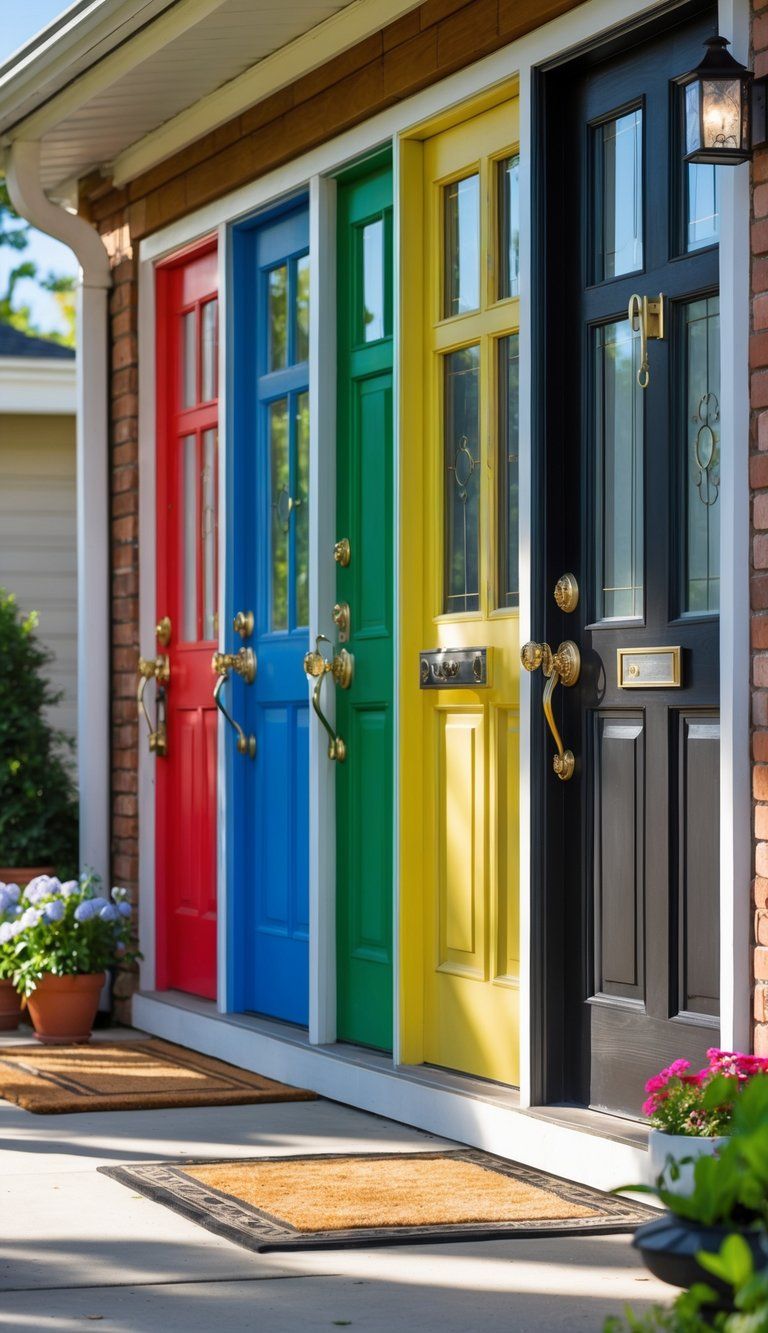
Colors have always stirred emotions and carried meaning. A black door feels powerful and sophisticated, but a cheerful yellow says, “Hey, come on in!” with a dose of optimism.
Blue front doors? They can feel calm or confident, depending on the shade. Each one sends a different signal about who lives inside.
When you’re picking a front door color, think about what feels timeless but also what feels like you. The best color fits your home’s style, the landscape, and your own preferences.
Maybe you love bold reds that shout energy and passion, or maybe you lean toward subtle neutrals for that quiet elegance. Either way, your front door color gives visitors a hint about what’s inside before they even knock.
How Front Door Colors Influence First Impressions
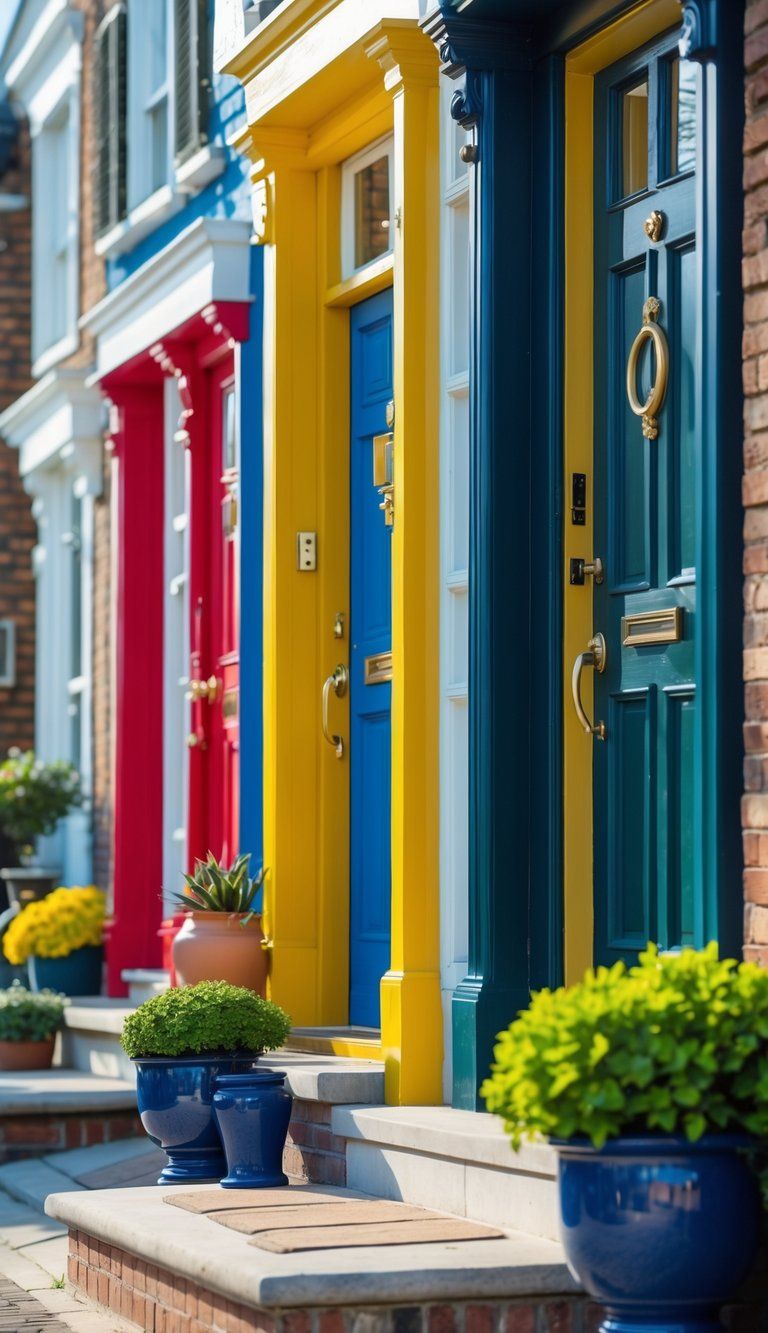
Your front door grabs attention right away. The color you pick shapes the vibe and says a lot about the people inside.
The Impact of Color on Curb Appeal
Front door colors can make or break your curb appeal. The right color can help a simple home stand out.
People often find dark colors like black, charcoal, or navy elegant and sophisticated. These shades can really attract buyers.
Bold colors make your place memorable. If you go for a bright red or yellow, your home might just become the one everyone remembers—“Oh, it’s the house with the turquoise door!”
Real estate experts have noticed that homes with thoughtfully chosen front door colors often sell faster. Sometimes, they even fetch higher prices.
A Zillow study even found that black or dark gray doors could add up to $6,000 to a home’s sale price.
Your home’s style matters too. Colonial homes look sharp with traditional red doors, while modern homes can pull off orange or lime green.
What Your Front Door Color Says About You
Your front door color gives away a bit of your personality. Red doors? They say you’re energetic, passionate, and probably love having friends over.
Blue doors hint that you appreciate peace and stability. Lighter blues feel approachable, while navy suggests you’re reliable and maybe a little brainy.
If you’ve picked green, you probably care about nature and harmony. You might be practical and like things balanced.
People who go for black doors usually have a classic sense of style and a lot of confidence. You probably know what you like.
Yellow or orange? You’re likely creative, optimistic, and don’t mind being noticed.
White doors point to someone who values simplicity and order. Maybe you’re a traditionalist or just like things neat.
Cultural Meanings and Symbolism
Front door colors mean different things in different places. Back in American Colonial days, a red door meant travelers could find a safe place to stay.
Some churches still use red doors to symbolize sanctuary and protection.
In Chinese culture, red doors bring luck and prosperity. Many families paint their doors red before Chinese New Year to invite good fortune.
Blue doors show up a lot in Mediterranean countries, where people believe they keep away evil spirits. The tradition comes from the idea that evil can’t cross water, and blue stands for the sea.
In Ireland, people started painting their doors bright colors to set their homes apart—originally as a bit of rebellion during British rule.
Feng Shui says your front door color should match the direction it faces. South-facing doors do well with red or orange, while blue or black suits north-facing entrances.
Understanding Color Psychology for Entryways
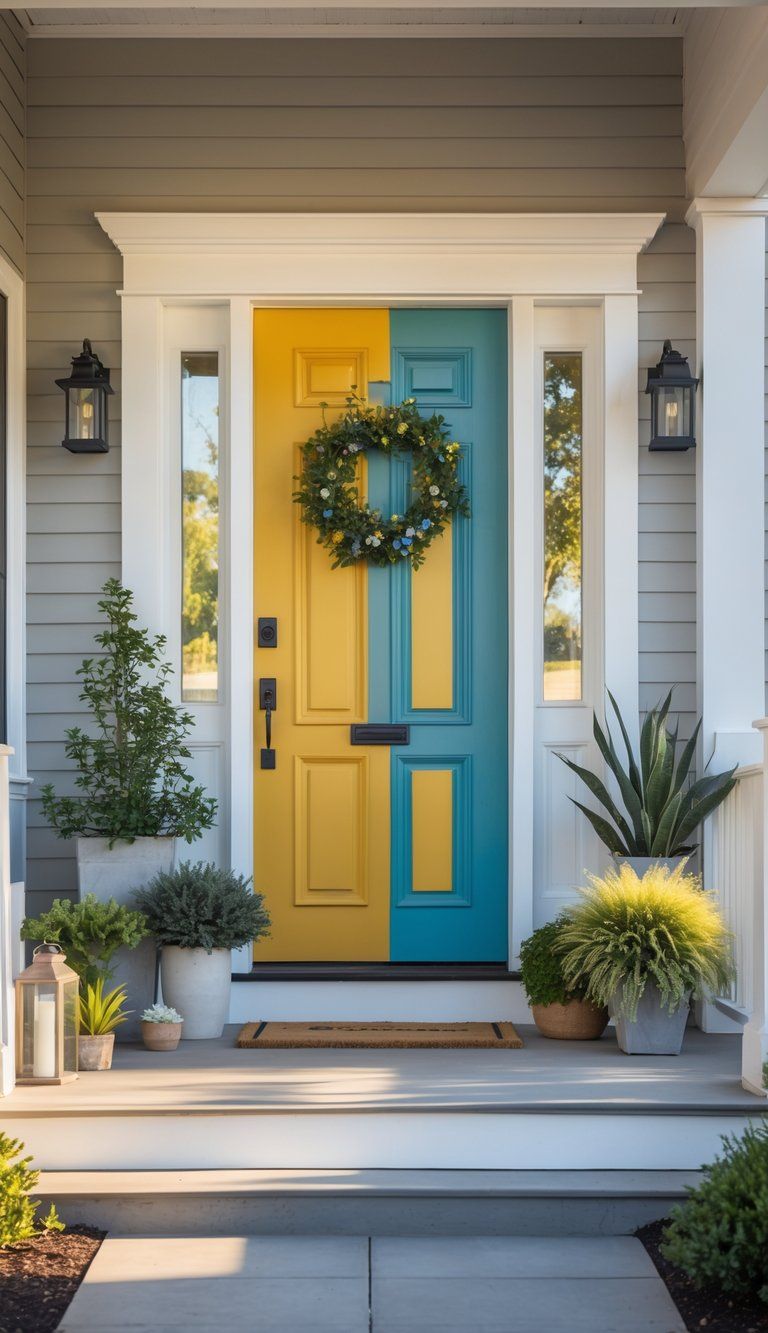
The color of your front door can totally shift the mood for you and your guests. Color psychology really does play a part in how we feel about a space.
Warm vs Cool Colors and Their Effects
Warm colors like red, orange, and yellow bring a jolt of energy to your entryway. Red doors, for example, feel welcoming in so many cultures and really make a statement.
They’re bold and perfect if your home needs a little pop.
Cool colors—think blue, green, or purple—create a calm, peaceful vibe. Blue front doors make people feel relaxed even before they step inside.
Some shades, like Benjamin Moore’s Soft Sky or Sherwin-Williams’ Hinting Blue, offer a gentle, refreshing welcome.
Green doors stand for growth and harmony with nature. They look especially good on homes surrounded by plants, blending the outside and inside.
Timeless vs Trendy Color Choices
Black and white doors never really go out of style. Black feels strong and sophisticated, while white just looks clean and simple.
Gray has become a modern neutral that works with both old-school and new-school designs. It gives a soft elegance without being as stark as black or white.
Trendy colors like coral, teal, or mustard yellow can make your home pop, but they might need updating sooner as styles change. Victorian homes often wear rich, jewel tones well, while mid-century modern houses look great with brighter, playful colors.
Feng Shui Principles for Front Doors
Feng Shui calls the front door the “mouth of chi”—it’s where energy comes into your home. The color should match the direction your door faces for the best flow.
South-facing doors get a boost from reds, oranges, or purples. East or southeast doors like browns and greens, which represent wood energy.
North-facing doors work with blues and blacks, and west-facing ones look good with white or metallics.
Pick a color that matches your energy needs. If you want more pep, go for warm colors. If you need calm, cooler tones help balance the vibe.
Keep your door looking good—chipped paint or worn spots can block positive energy, no matter what color you pick.
Matching Front Door Colors With Architectural Styles
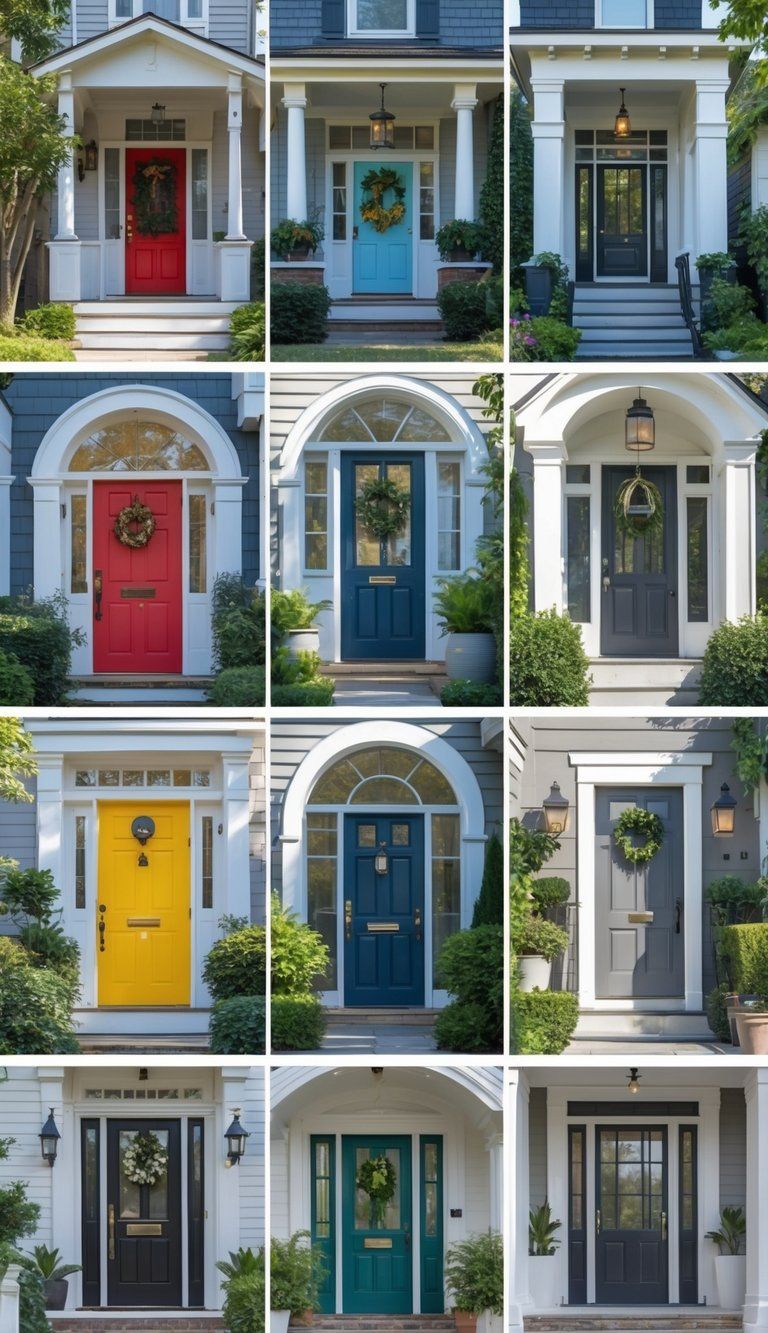
The right front door color should fit your home’s architecture. When you get it right, your home’s character really shines.
Traditional Homes and Classic Hues
Traditional homes—think Colonials, Victorians, or Craftsman styles—tend to look best with classic, refined colors.
Colonials look great with deep navy blue, burgundy, or hunter green doors. These shades keep things authentic and classy.
Victorian homes let you play a bit more. Try rich plums, deep teals, or even warm golds to match their fancy trim.
Craftsman homes shine with earth-toned doors like olive green, warm brown, or muted blue-green. These colors fit their natural, handcrafted vibe.
For traditional homes, you might want:
- Black or dark brown for a timeless look
- Deep reds for a classic, welcoming statement
- Navy blue for always-on-point sophistication
Modern Homes and Bold Colors
Modern homes let you get creative with color. Their clean lines and simple shapes really make bold hues pop.
Mid-century modern homes look fantastic with bright orange, sunny yellow, or turquoise doors. These shades echo the fun, optimistic style of that era.
For contemporary homes with industrial touches, you can try:
- Bright red for major contrast
- Electric blue for a burst of energy
- Charcoal gray for a sleek, minimal feel
Ultra-modern homes with lots of glass and metal look sharp with high-gloss black or white doors. Or, you could go wild with lime green or fiery orange for a real statement.
Coordinating With Architectural Details
Your front door should work with the details around it—think stonework, trim, or windows. Check out your home’s permanent features for color ideas.
For brick homes, match the door to undertones in the brick (like warm reds with red brick) or pick a color that pops (like navy on light brick). Stone homes with lots of colors give you options—pull a subtle shade from the stone for a pulled-together look.
Some quick coordination tips:
-
Match hardware to your door color: Oil-rubbed bronze looks great on dark doors, while brushed nickel works with cooler shades.
-
Pay attention to window trim: Your door color should either match or intentionally contrast with the trim for a balanced look.
-
Think about the roof: Dark roofs often look better with deep door colors. Lighter roofs let you play with brighter shades.
Choosing the Right Front Door Color for Your Home Exterior

Picking the right front door color brings your home’s style and your personality together. The right shade can boost curb appeal and say a lot about your place.
Complementary and Analogous Color Schemes
If you want your front door to stand out, the color wheel is your friend. Complementary colors—those across from each other on the wheel—create bold contrast.
A blue door on an orange-brick house, for example, really pops.
Analogous schemes use colors next to each other on the wheel. This feels more subtle and harmonious. A sage green door on a beige house with brown trim just flows.
Always test paint swatches at different times of day. Sunlight can totally change how a color looks. Paint stores usually have small samples so you can try before you commit.
Working With Trim and Exterior Paint Colors
Your front door should work with your exterior paint and trim colors. Here are a few ways to keep things looking good:
- Contrast: Go for a door color that stands out from your siding (like black on white).
- Accent: Pull a shade from your landscaping or architectural details.
- Monochromatic: Use a lighter or darker version of your main house color.
Aim for balance. A bright red door looks awesome on a neutral gray house but might clash with bold blue siding. Neutral door colors—black, dark gray, deep brown—pretty much always work and never really go out of style.
Considering Material and Finish
The material of your door changes how paint looks and lasts. Wood soaks up paint differently than fiberglass or metal. If your door has a nice grain, some paints let that show through.
Finish matters too:
- Glossy: Colors look richer but show every flaw.
- Semi-gloss: Durable with a bit of shine.
- Satin: Soft glow, hides small dings.
- Matte: Modern, hides imperfections.
Think about your climate. Dark colors soak up heat and might warp in hot places. Light colors show dirt more in rainy spots. Always use exterior paint made for doors so your color lasts.
Popular Front Door Colors and Their Meanings
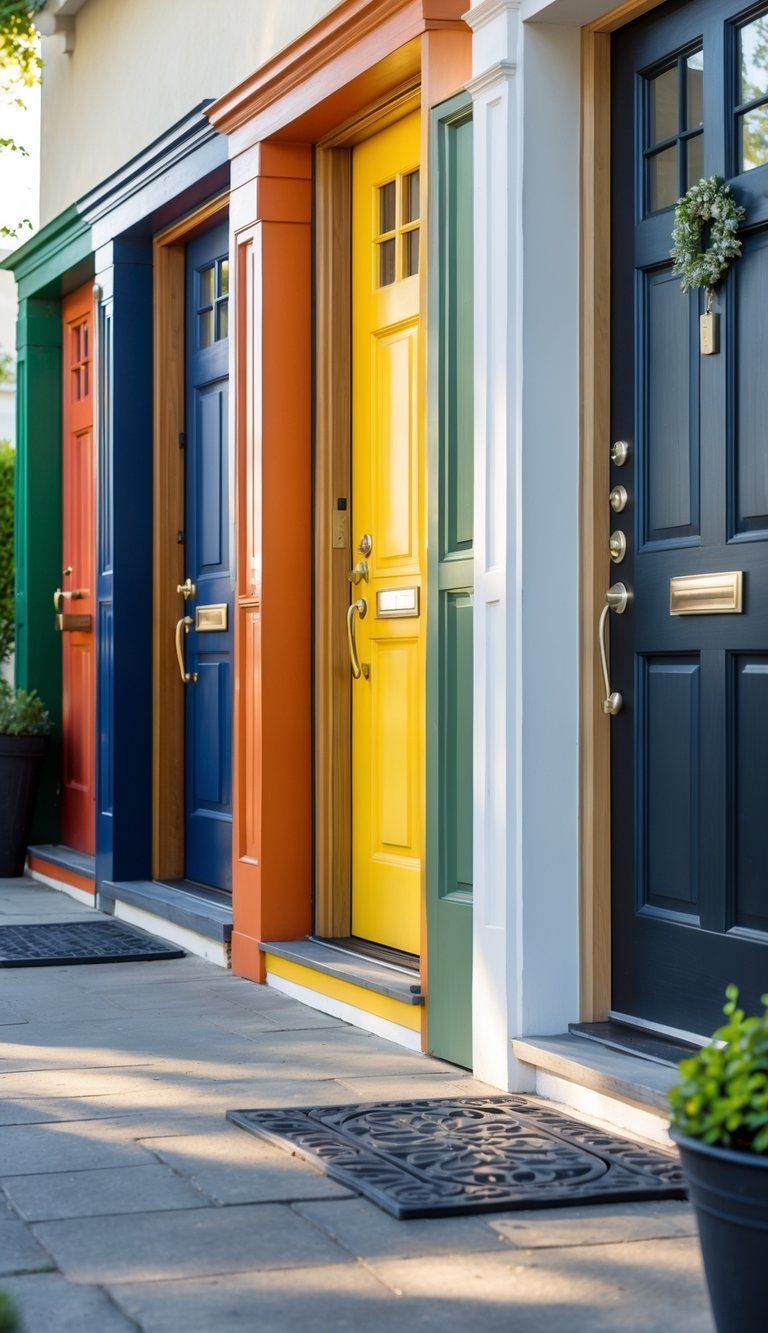
Your front door color says a lot about you and sets the mood for your whole home. Each color makes a unique impression, shaping what people think before they even walk inside.
Red and Burgundy Front Doors
Red front doors grab attention right away. In a lot of cultures, a bright red door means welcome and hospitality. Back in early American days, a red door let travelers know they could safely rest there for the night.
In Chinese culture, people see red as a symbol of good luck and prosperity. Many homeowners pick this bold color hoping it brings positive energy to their homes.
Burgundy gives you a more sophisticated spin on red. It feels elegant and stable but still friendly and inviting. This shade looks especially nice on Colonial or Victorian homes.
If your house has neutral siding, a red or burgundy door really pops and instantly boosts curb appeal.
Black and Charcoal Gray Doors
A black front door always looks classy and elegant. Lots of homeowners choose black because it never really goes out of style. Black gives off a vibe of strength and tradition, suggesting the owner values security.
You can pair black doors with almost any exterior color scheme. They look especially sharp on white or light-colored homes.
Charcoal gray is a bit softer than pure black but just as refined. This shade feels modern and understated—perfect for today’s homes.
Both black and charcoal gray make your entrance look more substantial. Plus, darker doors hide dirt and fingerprints better than lighter ones.
Blues: Navy, Royal, and Powder Blue
Homeowners often pick blue front doors. Deep navy blue gives a sense of trust and stability, making people feel welcome and secure. Classic navy fits right in with traditional or coastal homes.
Royal blue feels more energetic but still sophisticated. It’s perfect if you want to stand out a little but not too much.
Powder blue is softer and soothing. This gentle color creates a peaceful entrance, especially on cottage-style or beach houses.
You’ll usually find blue doors work well with brick, stone, or white exteriors. Most people find blue appealing, which helps if you’re planning to sell your home someday.
Exploring Green, Yellow, and Unique Color Choices
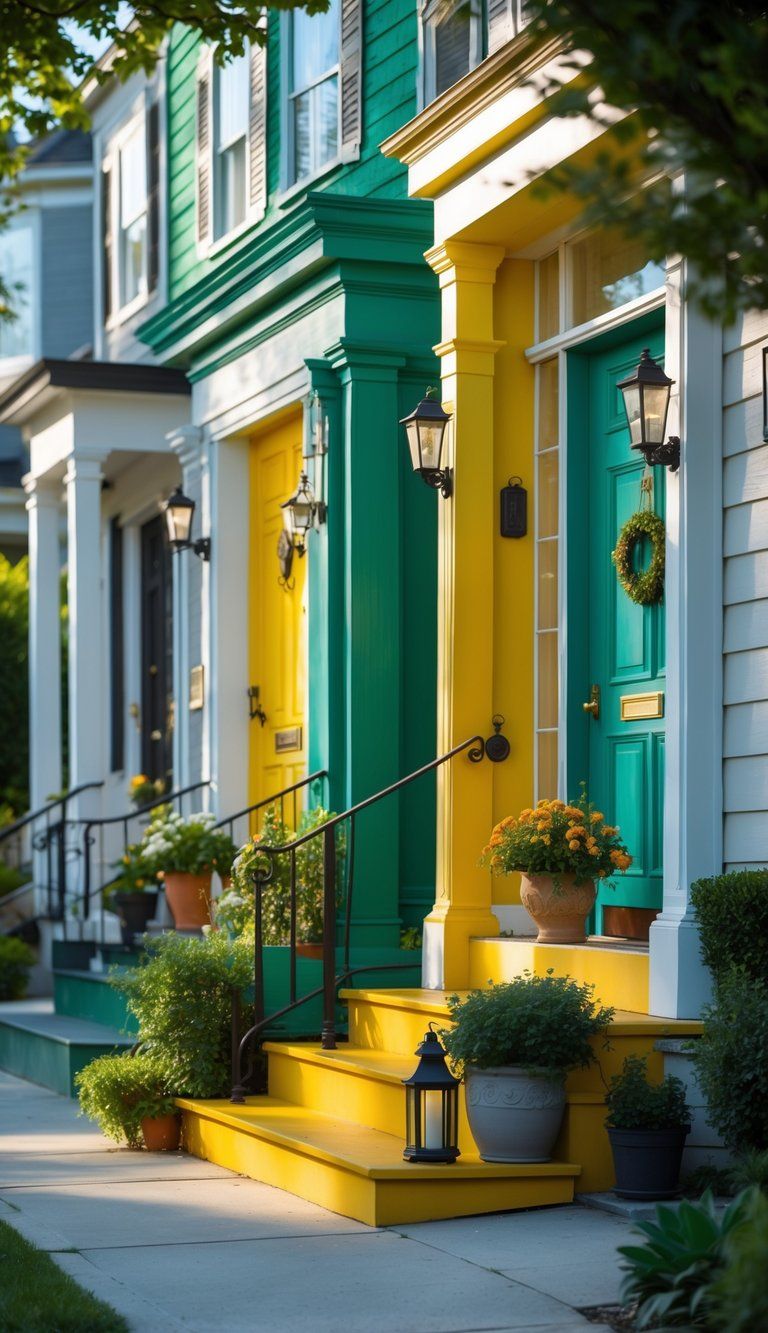
If you’re tired of traditional door colors, you’ve got a lot of fun options. Vibrant doors make your house stand out and show off your personality.
Green Front Doors: Sage, Forest, and Teal
Sage green doors feel calm and welcoming, and they match up with a lot of different home exteriors. This muted green connects to nature and gives off peaceful vibes. It looks great with brick or neutral siding.
Forest green makes a bolder statement but still feels sophisticated. This deep shade works well on traditional homes or houses with stone accents. It suggests stability and even a bit of luxury.
Teal mixes blue and green for a fresh, coastal look. You can use teal on both modern and traditional homes. It brings creativity and emotional balance. If you want teal to stand out, pick a shade with enough depth so it doesn’t blend into the background.
Sunny Yellow, Pale Yellow, and Yellow Front Doors
Yellow front doors instantly make your entryway feel cheerful. Yellow means optimism, energy, and warmth—perfect if you want your guests to feel welcome before they even come inside.
Sunny yellow pops on homes with neutral exteriors like gray, white, or beige. It makes a confident statement and draws the eye to your entry.
Pale yellow is a quieter choice but still warm and inviting. This shade works nicely with traditional homes and pairs well with stone or wood. For the best look, pick a yellow that matches your home’s undertones.
Unconventional Colors: Purple, Orange, Pink, and Turquoise
Purple front doors really stand out. Whether you go with deep eggplant or pale lavender, purple says creativity and originality. It looks especially good on gray, white, or beige houses.
Orange doors bring a burst of energy and enthusiasm. Shades like burnt orange or coral feel welcoming right away. Just be careful—super bright orange can sometimes overwhelm certain home styles.
Pink front doors—anything from soft rose to magenta—add unexpected charm. Pink feels nurturing and compassionate. Surprisingly, pink works with many exteriors if you pick the right shade.
Turquoise doors give you a fresh pop of color that feels both unique and classic. This blue-green shade becomes a focal point but still blends nicely with most exteriors. It hints at creativity and emotional healing.
Coordinating Front Door Colors With Home Exteriors
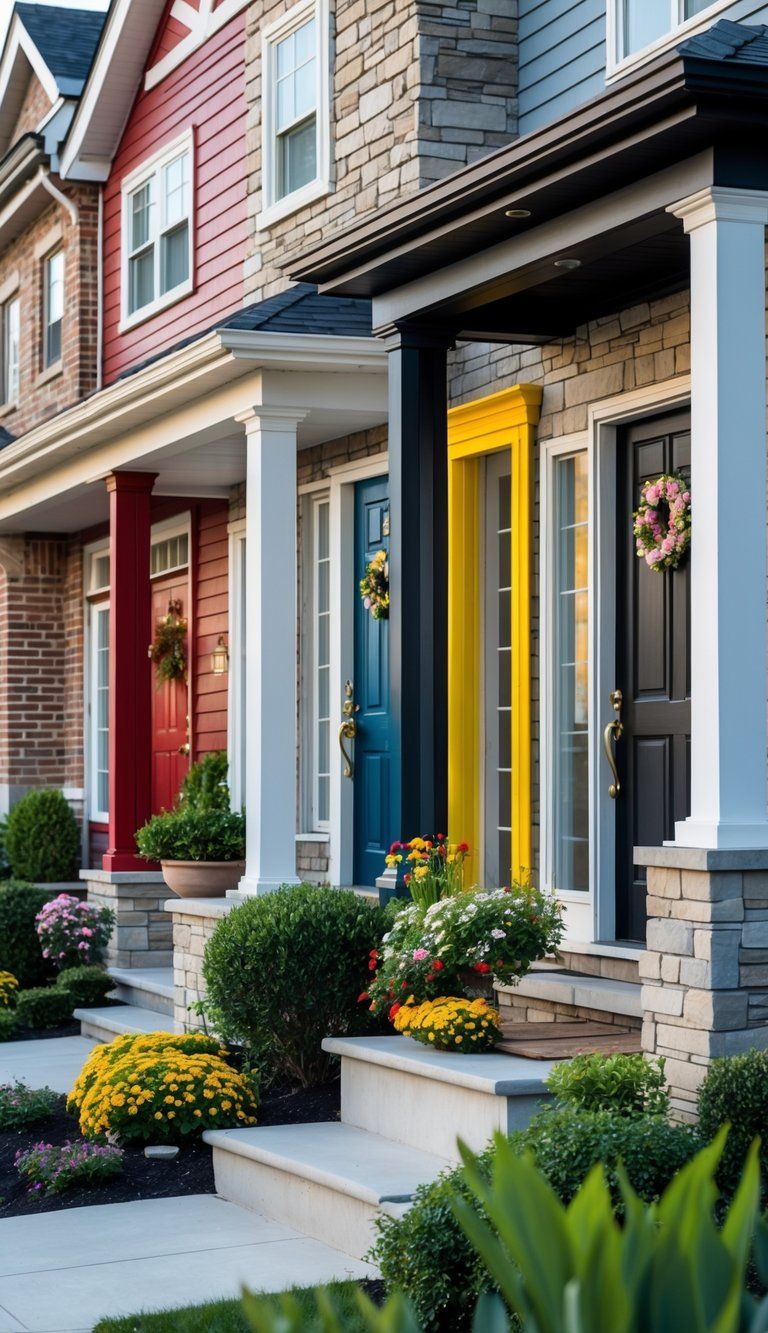
Picking the right front door color can totally change your home’s look. It’s important to think about how your door color fits with the rest of your exterior materials and colors.
Blue Houses: Color Pairing Ideas
Blue homes give you lots of room to play with door colors. If you’ve got a navy or dark blue exterior, try a bright yellow or orange door for a bold contrast. Warm colors like these really pop against blue.
For lighter blue homes, white doors create a fresh, coastal vibe. Red doors on blue homes give a bold, patriotic look while still feeling sophisticated.
Gray-blue homes look great with forest green or burgundy doors. These add richness without taking over the subtle blue exterior.
Try these combos:
- Light blue house + crisp white door = fresh, coastal
- Navy blue + yellow door = eye-catching contrast
- Blue-gray + burgundy door = sophisticated charm
Brown, Beige, and Gray Homes
Neutral houses are a blank canvas for door colors. For beige or tan homes, jewel tones like emerald green, sapphire blue, or ruby red add personality.
Gray homes are super flexible. Dark charcoal exteriors look modern with bright white doors. Medium gray pairs well with teal, mustard yellow, or even purple if you want to make a statement.
Brown homes, especially with terracotta, look great with sage green, turquoise, or deep red doors. Earthy exteriors also pair well with black doors for a timeless feel.
Some pairings to try:
- Beige house + turquoise door = refreshing contrast
- Gray house + bright yellow door = cheerful statement
- Brown house + black door = classic elegance
Red Brick and Yellow Houses
Red brick homes have a lot of character and can handle certain door colors beautifully. Navy blue doors add traditional elegance, and black feels timeless. If you want something different, try forest green or a rich plum.
Yellow houses really shine with contrasting doors. Navy blue feels nautical and classic, while charcoal gray brings a bit of subtlety. For a playful look, try teal or turquoise against yellow.
Both brick and yellow homes can pull off white doors for a crisp, traditional look. Coordinating your door color with shutters, trim, and garage doors helps the whole exterior feel put together.
Some ideas:
- Red brick + navy door = traditional elegance
- Yellow house + teal door = cheerful personality
- Brick home + white door = clean, classic appeal
Achieving a Cohesive Look With Front Entry Details
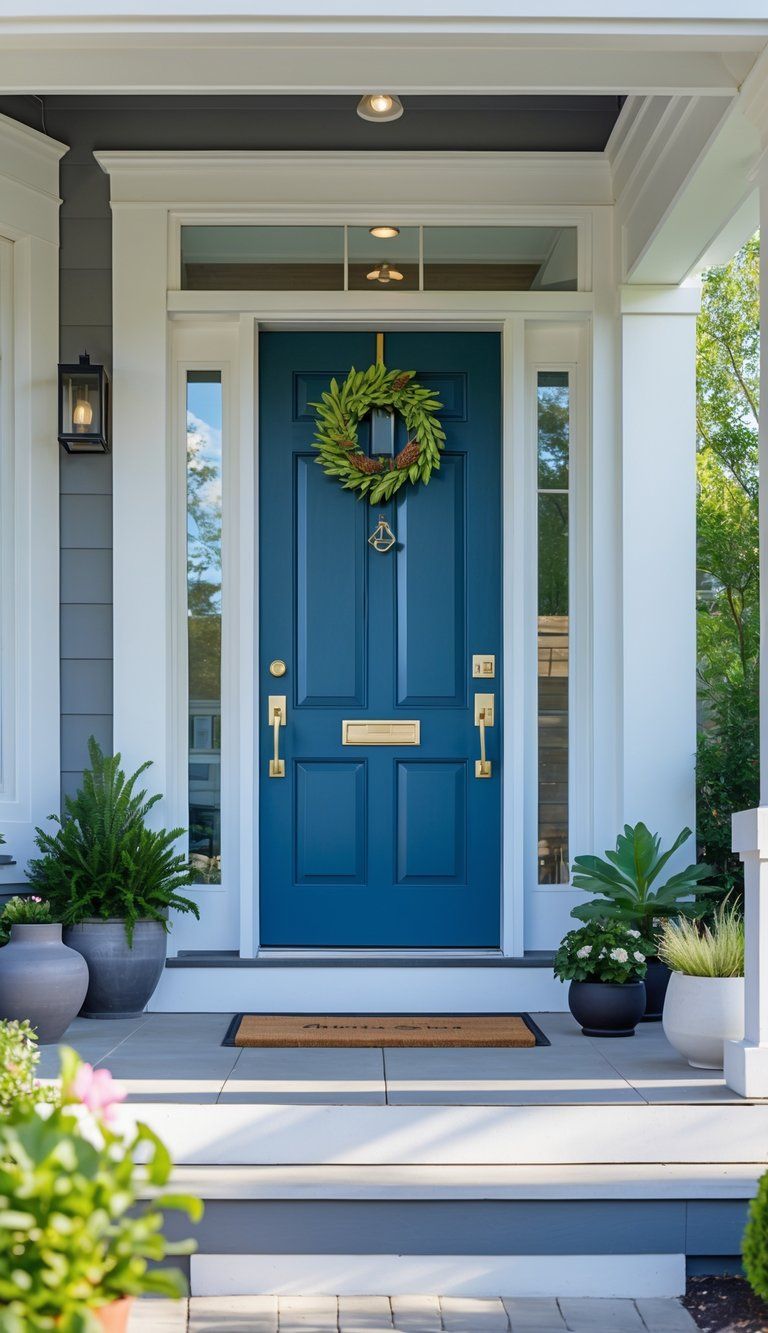
Your front entrance really sets the mood for your home. To get a cohesive look, you need to think about everything: door color, hardware, and even the little decorative touches.
Working With Screen Doors and Front Porches
Screen doors add both function and style. Pick a screen door that matches your main door’s design instead of clashing with it.
Colonial or traditional homes look good with wooden screen doors that have decorative panels. Modern homes look best with sleek metal frames and simple designs.
Your front porch should flow naturally from your home’s architecture. Use similar colors and materials to tie everything together.
Match porch furniture finishes to your door hardware for an extra touch. For example, if you have bronze door handles, go for bronze light fixtures or furniture accents.
A weather-resistant outdoor rug can pull your color scheme together and make the porch feel cozy.
Natural Wood and Timeless Finishes
Natural wood doors bring warmth and work with all kinds of architecture. Cedar, oak, and mahogany are all solid choices that age nicely.
Let wood doors show off their natural grain with clear sealants. This look suits craftsman, rustic, and mid-century modern homes really well.
For hardware, go with brushed nickel, matte black, or oil-rubbed bronze. These finishes rarely go out of style and blend nicely with wood tones.
Repeat your chosen metal finish in nearby light fixtures, house numbers, and mailboxes. It’s a subtle way to tie everything together.
Monochromatic and Bold Design Strategies
A monochromatic color scheme feels instantly sophisticated. Try painting your door, trim, and nearby accents in different shades of the same color.
For example, a navy blue door with lighter blue planters and a pale blue porch ceiling creates depth but still looks coordinated.
Bold door colors can really stand out, but you need a plan. If you go with something vibrant like red, yellow, or turquoise:
- Avoid too many competing colors nearby
- Use neutral shades for the other elements
- Repeat small touches of your bold color in accessories
Lighting changes how colors look, so test your choices at different times of day before you commit.
Decide if you want your hardware to match or contrast with a bold door. Black hardware on a bright yellow door is dramatic, while brass adds warmth.
Front Door Color Ideas and Inspiration
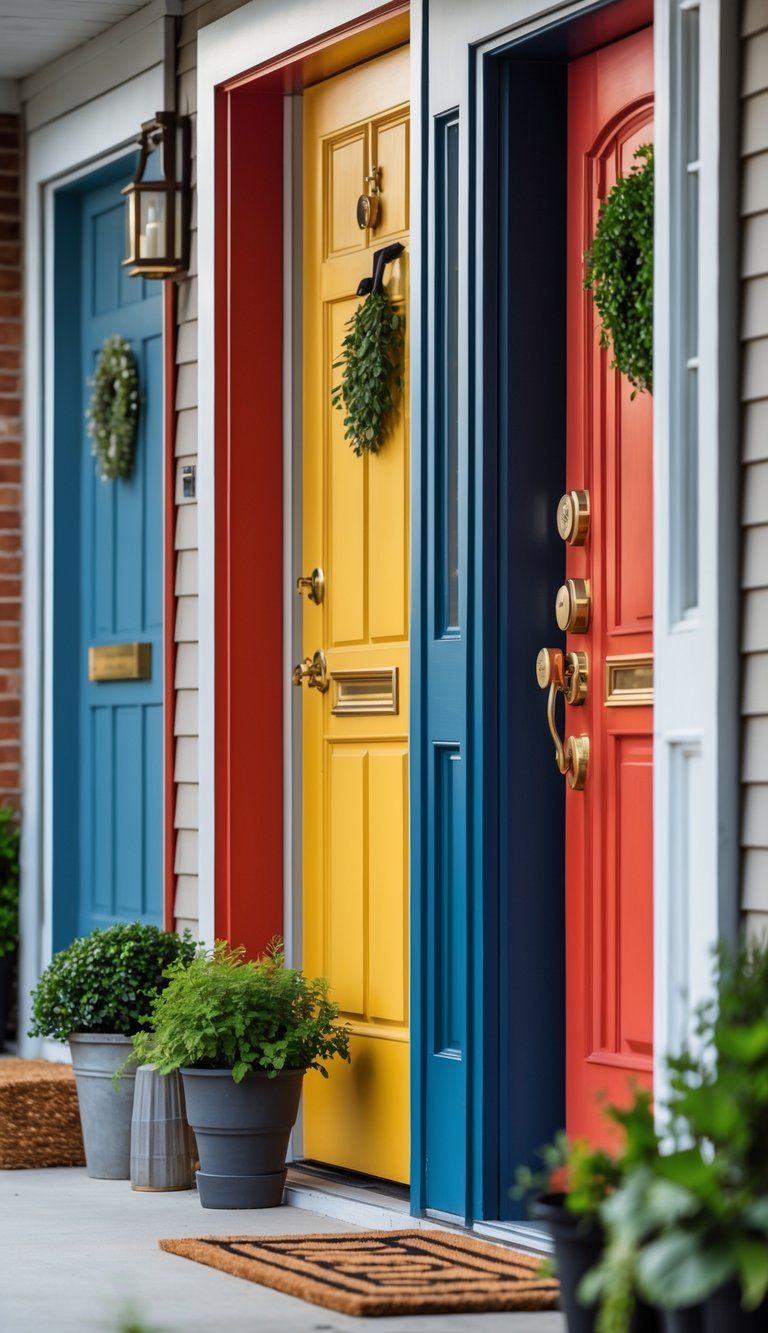
The right front door color can totally transform your home’s vibe. The perfect shade should reflect your personality and fit your home’s style and landscape.
Classic and Neutral Choices
White, Black, and Gray always feel timeless for front doors. White doors look clean and welcoming, especially on traditional homes. They work with a lot of exterior colors and offer a nice contrast to darker siding.
Black doors bring a sense of sophistication. They look especially good on Georgian-style homes, letting the architecture shine without competing.
Gray is a newer neutral that bridges classic and modern looks. Light gray doors work well with blue and green palettes, helping everything feel cohesive.
Navy blue and deep green have become popular “new neutrals.” They add character without overwhelming your home’s design.
Standout and Statement Doors
Bold colors can really boost curb appeal and show off your personality:
- Yellow: Bright and cheerful
- Red: Warm and energetic
- Blue: Calming in lighter shades, dramatic in cobalt
- Green: Fresh and connected to nature
Design trends for 2025 point to vibrant shades like turquoise, coral, and plum as popular picks for statement doors.
The trick is to choose a bold color that fits your home’s exterior and architecture. A bright door can become a focal point and make your entrance memorable.
Using Paint Swatches For Decision Making
Testing colors before you commit really matters. Go grab color swatches from the paint store and check them out at different times of day right up against your home’s exterior.
Some quick tips for using paint swatches without losing your mind:
- Hold the swatches against your door in the morning, at midday, and again in the evening.
- Look at how the color fits with your siding, trim, and even the landscaping.
- Pick two or three favorite colors and buy small sample sizes.
Once you’ve narrowed it down, paint a small section of your door—or just use a poster board—with each sample color. Watch how they change over a few days as the light shifts.
Honestly, colors can look way different on a big door than on a tiny swatch. Taking this extra step helps you dodge expensive mistakes and makes it much more likely you’ll actually love the end result.

